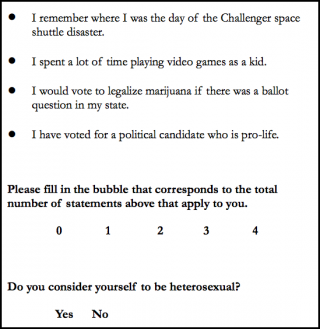Sexual Orientation
Homosexuality Is More Prevalent Than We Might Have Thought
Asking survey participants direct questions is a poor way to measure behavior
Posted October 17, 2013
Would you be happy to have an openly lesbian, gay, or bisexual manager at work? Do you think someone who is homosexual can change their sexual orientation if they choose to do so? Do you believe it should be illegal to discriminate in hiring based on someone's sexual orientation?
Survey questions like these help researchers measure the public level of acceptance of homosexuality and, importantly, have been used to argue that acceptance of homosexuality has increased rapidly as more and more jurisdictions adopt laws that give LGBT people the same rights and freedoms as heterosexuals.
What if, however, what appears to be an increasing acceptability of homosexuality is really an unwillingness of survey participants to admit to holding beliefs that are increasingly socially unacceptable?
It’s an interesting question and, thanks to new research at the NBER this week, we have a better understanding of how just how dishonest surveys participants can be when asked to reveal beliefs that are inconsistent with social norms – even when it is impossible to link the results of those surveys with the participants.
Here is how the experiment was conducted. Participants completed a survey in a private (online) setting in which they were asked a series of questions designed to test both their level of acceptance of homosexuality and to reveal their own homosexual tendencies. Participants were randomly split into two groups that differed only in the way that they question was posed.
One group was asked direct questions that looked like this:

And the second group was asked indirect questions that looked like this:

The distinction between the phrasing of these two questions might seem insignificant, but comparing the average responses between the two groups shows just how dishonest people can be when asked about their behavior and beliefs.
Among those who were asked directly 11% of the population reported that they do not consider themselves to be heterosexual (8% of men and 16% of women), while among who were asked indirectly (using what the authors called the “veiled” method) 19% reported that they did not consider themselves to be heterosexual (15% of men and 22% of women).
Among those who were asked directly if they had ever had a sexual experience with someone of the same sex 17% said they had (12% of men, 24% of women), while among those who were asked indirectly 27% said they had (17% of men and 43% of women).
When people are directly asked to reveal their sexual preferences, even when they do so privately, they significantly under-report homosexual preferences and behavior.
And when asked to reveal their attitudes, participants tended to over-state how accepting they are of homosexual behavior.
When the veiled method was used, the share that did not support the legal recognition of same sex marriage increased by 4 percentage points, the share that would not be happy to have a LGBT manager at work increased by 11 percentage points, the share that believes it should not be illegal to discriminate in hiring based upon sexual orientation increased 11 percentage points and the share of participants who believe that a person can change their sexual orientation if they choose to do so decreased from 22% to 15%.
Let me give you an example of why these results matter.
Last week, a Canadian researcher published a paper arguing that children who grow up in the LGBT households are less likely to graduate from high school [1]. Allen argues that the children of LGBT families have been subject to lower levels of stimatization in Canada because same sex marriage was federally legalized in that country in 2005. This new research suggests that his dataset probably signifcantly underestimates the number of adult children who self-report having same sex parents and that he is mistaken to assume that because it has become socially unacceptable to discriminate against such families that discrimination is no longer present.
Earlier this week, after I gave a talk on the economics of sex and love at the University of Minnesota, a student approached me and asked me why I preferred the economic perspective to other alternatives, like sociology. I told him that I appreciated the way that economics relies on observations of how people actually behave, rather than on self-reports of how they might behave. As this research illustrates, the less than we rely on self-reporting, the better we will be at understanding human nature.
[1] Others have done an excellent job at pointing out the many flaws in that research (see, for example, Philip Cohen's blog post at Family Inequality).
Reference:
Allen, Doug (2013). "High School Graduation Rates Among Children of Same Sex Households." Rev Econ Household.
Coffman, Katherine B.; Lucas C. Coffman, and Keith M. Marzilli Ericson (Oct. 2013). "The Size of the LGBT Population and the Magnitude of Anti-Gay Sentiment are Substantially Underestimated" NBER Working Paper No. 19508.


